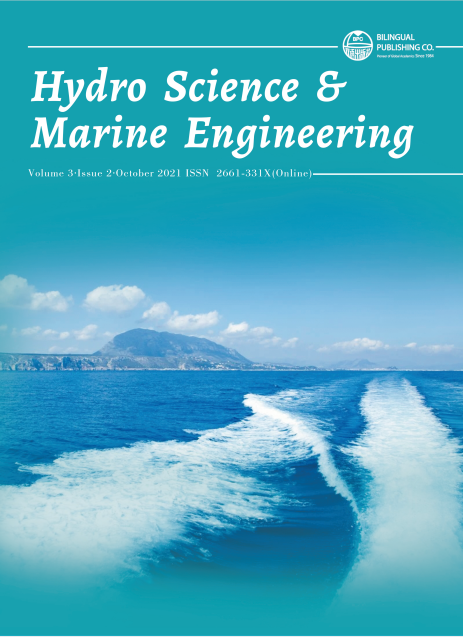Effects of Spur Dyke’s Orientation on Bed Variation in Channel Bend
DOI:
https://doi.org/10.30564/hsme.v3i2.3834Abstract
Spur dykes also known as Groynes are often used to either divert or attract the flow from the main structure to safeguard their life. Those structures may be bridge piers, abutments or any similar hydraulics structures. Spur dykes are also used to save the cutting of banks on concave side of stream. Lots of work have been done in recent past on spur dykes by many investigators in which various hydraulic and geometrical parameters of spur dykes such as discharge, sediment size, flow velocity, shear stress, spur dykes shape, size and submergence etc. are studied in detail. But mostly all the studies were pointed out in straight open channels. Very few studies were done in curved channel and only their similar effects were studied. In present thesis main emphasis is given to study the effect of orientation and location of spur dykes in meandering channel on the bed of downstream side. In the present study experimental work has been carried out in 80° bend and constant discharge (Q = 4.5 l/s) is allowed to pass in channel without spur dyke. It is found that maximum scouring occurs at angular displacement θ = 60° to 80° in the vicinity of outer bank. To minimize this scouring, spur dyke has been installed at angular displacement θ = 20°, 40° & 60° by changing the dyke angle α = 60°, 90° & 120° respectively. It is found that scouring at θ = 60° is reduced by installing spur dyke at angular displacement θ = 40° which is oriented at α = 60° and scouring at θ = 80° is reduced by installing spur dyke at angular displacement θ = 60° which is oriented at α = 60°.
Keywords:
Spur dykes, Inner bank, Outer bank, Bridge pier, Curved channel, LocationReferences
[1] M. Pandey, Z. Ahmad, P. K. Sharma, Scour around impermeable spur dikes: A review, ISH J. Hyd. Eng. (2017), 24:25-44.
[2] H. Zhang, H. Nakagawa, H. Mizutani,Bed morphology and grain size characteristics around a spur dyke, Int. J. Sediment Res., (2012), 27:141-157.
[3] M. F. M. Yossef, H. J. D.Vriend, Flow details near river groynes: Experimental investigation, J. of Hyd. Engg, (2011), 137:193-210.
[4] S. Karki, Y. Hasegawa, M. Hashimoto, H. Nakagawa,K. Kawaike, Short-term evolution of flow & morphology in an erodible meandering channel with & without groynes, Annu. J. Hyd. Eng., JSCE, (2018), 74:1147-1152.
[5] H. Zhang, H. Nakagawa, Characteristics of local flow and bed deformation at impermeable and permeable spur dykes, Annu. J. Hyd. Eng., JSCE, (2009), 53:145-150.
[6] Przedwojski, Bed topography and local scour in rivers with banks protected by groynes, J. Hyd. Res., (2015), 33:257-273.
[7] R.J. Garde, K.S. Subramanya, K.D. Nambudripad, Study of scour around spur dikes,J. Hyd. Eng., (1961), 87:23-27.
[8] M.A. Gill, Erosion of sand beds around spur-dikes, J. Hyd. Div. ASCE,(1972), 98:1587-1602.
[9] N.A. Zaghloul, Local scour around spur-dikes, J. Hydrol., (1983), 60:123-140.
[10] R. Kuhnle, C. Alonso,F.D. Shields, Geometry of scour holes associated with 90° spur dikes, J. Hyd. Eng. ASCE, (1999), 125:972-978.
[11] IS 8408: 1994, Planning and design of groynes in alluvial river-Guidelines, Bureau of Indian Standards Manak Bhavan, 9 Bahadur Shah Zafar Marg, New Delhi 110002.
[12] H. Zhang, Study on flow and bed evolution in channels with spur dykes, PhD thesis, Kyoto University, 2005.
[13] E. Elawady, M. Michiue, O. Hinokidani, Movable bed scour around submerged spur- dikes, Proc. of Hyd. Eng., (2001), 45:373-378.
[14] A. Parashar, N.K. Tiwari, M.Tech dissertation, Experimental study of spur dykes, Deptt of Civil Eng., NIT Kurukshetra, 2014.
[15] A. Masjedi, M. Bejestan, A. Moradi,Experimental study on scour depth in around a T-shape spur dike in a 180 degree bend,J. Am. Sci., (2010), 6:886-892.
[16] M. Vaghefi, M. Ghodsian,SalehiNeyshaboori,S.A.A, Experimental study on the effect of a T-shaped spur dike length on scour in a 90° channel bend.” Arab. J. Sci. Eng., (2009), 34:337.
Downloads
Issue
Article Type
License
Copyright and Licensing
The authors shall retain the copyright of their work but allow the Publisher to publish, copy, distribute, and convey the work.
Hydro Science & Marine Engineering publishes accepted manuscripts under Creative Commons Attribution-NonCommercial 4.0 International License (CC BY-NC 4.0). Authors who submit their papers for publication by Hydro Science & Marine Engineering agree to have the CC BY-NC 4.0 license applied to their work, and that anyone is allowed to reuse the article or part of it free of charge for non-commercial use. As long as you follow the license terms and original source is properly cited, anyone may copy, redistribute the material in any medium or format, remix, transform, and build upon the material.
License Policy for Reuse of Third-Party Materials
If a manuscript submitted to the journal contains the materials which are held in copyright by a third-party, authors are responsible for obtaining permissions from the copyright holder to reuse or republish any previously published figures, illustrations, charts, tables, photographs, and text excerpts, etc. When submitting a manuscript, official written proof of permission must be provided and clearly stated in the cover letter.
The editorial office of the journal has the right to reject/retract articles that reuse third-party materials without permission.
Journal Policies on Data Sharing
We encourage authors to share articles published in our journal to other data platforms, but only if it is noted that it has been published in this journal.




 Mohammad Athar
Mohammad Athar

